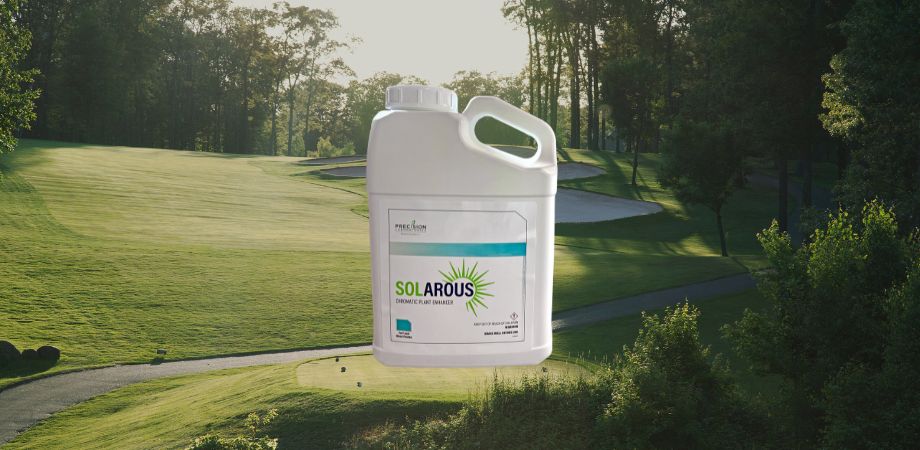How Pre-Emergents Work
We talk a lot about the usefulness of pre-emergent herbicides against weeds on golf courses. But what do they actually do?
As the name implies, pre-emergent herbicides target weeds before they emerge. Pre-emergent herbicides prevent the establishment of weed seeds during germination. For that reason, it’s crucial to apply pre-emergents before germination. The timing will vary by location and weather, but the first week of April is typically a reasonable estimate.
Pre-emergent herbicides are residual, meaning that they continue to work beyond the time of application. However, they degrade over time. The herbicides degrade quickly at first, then more slowly after a while. Because of deterioration, it’s important not to apply pre-emergents too early—the longer between application and germination, the more time the herbicide will have to dissipate. Reapplication helps maintain an adequate level of herbicide in the soil, but a well-timed first application is the best way to achieve success.
Pre-emergent herbicides come in granular forms applied with a broadcast spreader and liquid forms applied with a sprayer. Some fertilizers, both granular and liquid, contain pre-emergent herbicides so that you can apply them at the same time. Regardless of application form, it’s important to water in pre-emergent herbicides or apply them before a rainfall so they will absorb into the soil.
Making the Most of Pre-Emergents
Dithiopyr and prodiamine are two popular pre-emergent herbicides, and they each work differently to prevent weeds. Knowing their differences will help you use them more efficiently.
Dithiopyr is a pre-emergent and early post-emergent, which means it controls the plant before and after it has germinated. That gives you a longer window of time to apply dithiopyr. Prodiamine, on the other hand, only prevents seeds from germinating. That means you must apply prodiamine before weeds germinate to see results.
When it comes time to apply pre-emergents, there are a few things to make the job easier.
Split applications can be beneficial. Dithiopyr applications approximately four to six weeks apart have been shown to improve seasonal control. If you’re in an area where the summer is historically hot, split applications can create a significant benefit. That’s because a hot summer can break down chemistry more quickly and cause products not to last as long.
Using penetrants with pre-emergents improves results. More than one factor can affect the quality and duration of both dithiopyr and prodiamine applications, and thatch is one of them. Who hasn’t been in a situation where you treated for crabgrass, but it still popped up on slopes or other areas? In this situation, typically, most of the pre-emergent never made it to the soil. Instead, it washed down the slope carried by the hydrophobic thatch. Whether you intend to spread your pre-emergent on a fertilizer carrier or spray it, the use of a quality penetrant will significantly enhance your results. When applying liquid applications of Dimension or Kade, use a penetrant like Command to increase the efficacy of these sprays.
Another factor that can cause pre-emergent failure is irrigation. Irrigation and rainfall are vital for the success of absorbing the chemical into the soil.
Try a liquid combination product in areas where complete vegetation control is desired, such as landscape beds, gravel paths, and walkways. ProDeuce (glyphosate and prodiamine) and Specticle Total (glyphosate, diquat, and indaziflam), provide a total kill active ingredient (glyphosate and diquat) in combination with a pre-emergent (prodiamine or indaziflam). This provides control of actively growing weeds and grasses as well as extended pre-emergent control for the coming weeks or months. Spray applications of these types of products require care, as they do contain “non-selective” control agents that will harm desirable species.
Apply any of the following products to see results.
Pre-emergents are also useful in native or unmowed areas to help prevent undesirable plants. Pendulum AquaCap is uniquely suited for this application, with a “protective cap” surrounding the active ingredient. Two applications (one in the spring and one in the fall) are recommended for areas that previously have not been treated.
A helpful practice that could save you time is simply making note of past applications. Monitor treated areas for results using maps, detailed notes, and pesticide records. By doing this, you will know where you’ve had weed pressure in the past and can use a higher rate in those areas.
Don’t Apply Pre-Emergents Too Early
Yes, there is such a thing as applying pre-emergents too early. But how soon is too soon?
You’re probably eager to control crabgrass and goosegrass on your golf course, preferably before they become a visible problem. But pre-emergent herbicides are most effective when applied at the proper time, and sometimes that requires patience.
Pre-emergent application timing is less about the calendar than it is about soil temperature. Most crabgrass and goosegrass germination happens when the top two inches of soil are between 60°F and 70°F. Apply pre-emergents at soil temperatures between 50°F and 55°F for optimal results.
If you apply pre-emergents too far in advance of the proper temperature, they will be less effective at the time of weed germination. Application timing is crucial because the chemicals naturally degrade over time. Likewise, split applications are a good way to maintain herbicide activity throughout the growing season. Hot summer temperatures also contribute to degradation of the pre-emergent chemistry, which is another good reason to do split applications.
Michigan State’s Growing Degree Day Tracker is a good tool for determining the best time to apply pre-emergents on your golf course. Your ATS sales representative is also happy to advise on timing and products. Contact them today with any questions you may have.












